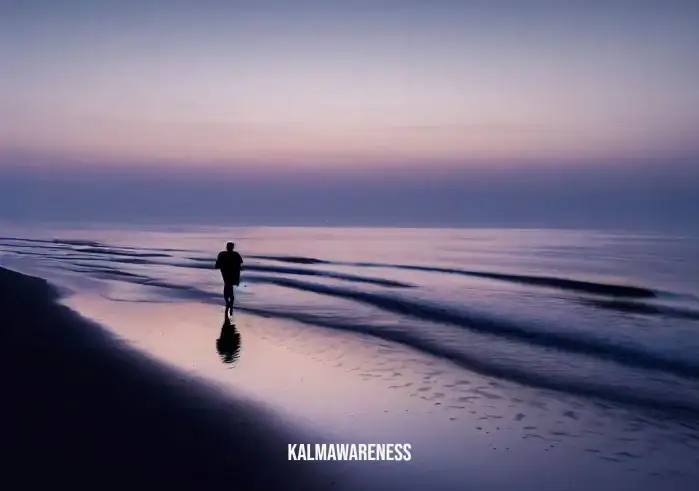Unraveling the Map of Habits with Jud Brewer: A Journey of Mindfulness and Personal Growth
In our quest for self-improvement and personal growth, there is one word that surfaces time and time again: habit. From the patterns of our thoughts to our daily routines, habits form the roadmap of our lives. Today, we delve into the world of habits with the expertise of Dr. Jud Brewer, a renowned mindfulness expert, and his innovative approach, “Map My Habit.”
As humans, we are creatures of habit. We are, in essence, sculpted by the habit of thought. But have you ever considered the power of mindfulness in reshaping this habit? Mindfulness, a practice steeped in pattern of thought, opens up a new world of possibility. It allows us to decode the pathways of our mind and introduces us to a state of ‘conscious awareness.’
Habit formation isn’t inherently harmful. Like a well-practiced mindful habit, it can help us navigate our daily lives with ease. But what happens when the habit loop turns destructive or counterproductive to our growth? This is where Dr. Brewer’s revolutionary approach comes into play.
Unmasking the Habit Loop with Jud Brewer
Dr. Brewer, with his expertise in mindfulness, aims to hack the habit loop and offers a perspective that transforms our understanding of habit formation. In his book, “Map My Habit,” Dr. Brewer introduces us to the concept of ‘noticing, shifting, and rewiring.’ A method presented in notice shift rewire that serves as a roadmap to mindful habit change.
A journey through this process begins by noticing the habit. Whether it’s procrastination, overthinking, or stress-eating, the first step is awareness. We need to be mindful of our habits, their triggers, and their impacts. Much like the thought-provoking articles in mindful series, this stage of the process requires active engagement and introspection.
With awareness in place, the next step is to shift. Shifting involves a conscious decision to change the path. It’s about making mindful choices, something extensively discussed in mindful choices. It’s not about a sudden, drastic change but a gentle nudge in the right direction.
The final step in the process is rewiring. Here, we replace the old, undesired habit with a new, more beneficial one. It’s akin to remodeling our minds, much like the foster remodeling solutions that breathe new life into our living spaces.
The Role of Mindfulness in Habit Change
Mindfulness is the key that unlocks the door to habit change. But how does one become mindful? How can mindfulness be integrated into our lives, leading us to make better choices and create healthier habits?
The practice of mindfulness often begins with mastering mindfulness, which is no small feat. It’s a journey that requires time, dedication, and a willingness to explore our inner selves.
One way to embark on this journey is through mindful eating. As explored in mindful eatz, mindful eating is a practice of being fully present and engaged in the act of eating. It’s about savoring every bite, every flavor, and every sensation. This exercise in mindfulness can be a stepping stone to greater awareness in other areas of life.
Then there’s the practice of mindfulness meditation. Dr. Brewer’s guide on breaking the habit of being yourself meditation is an excellent resource for anyone seeking to understand and integrate mindfulness meditation into their life. A habit of daily meditation, as explored in the 30-days meditation challenge, can serve as a solid foundation for mindful living.
Remember, mindfulness isn’t just a practice. It’s a way of life. It’s about making mindful changes and living mindfully, one moment at a time.
The Intersection of Mindfulness, Habit, and Personal Growth
It’s essential to remember that our journey to personal growth is intertwined with our habits and mindfulness. As we learn to let go of everything we fear to lose, we create space for new habits and new growth.
Mindfulness, with its emphasis on being present and fully engaged, helps us shed unproductive habits. The practice of mindfulness paves the way for growth, as we become more attuned to our thoughts, feelings, and actions. This harmony between mindfulness and habit can lead to significant personal growth, something beautifully illustrated in mindful harmony app.
By understanding our habits through the lens of mindfulness, we can uncover the areas in our life that require change. We can then set out on a path to growth, armed with tools for change, like hacking the habit loop and implementing the habit extension method, as discussed in habit extension method.
We invite you to continue to the next part of this enlightening article, where we will delve deeper into the nuances of Dr. Jud Brewer’s “Map My Habit” and further explore the incredible intersection of mindfulness, habit, and personal growth. We’ll discuss how to navigate the trials of habit change and the role of self-compassion in this journey. Stay tuned for a deeper dive into the transformative power of mindfulness.

The Science Behind ‘Map My Habit’ by Jud Brewer and its Impact on Personal Growth
Understanding the intricacies of ‘Map My Habit’ by Jud Brewer is essential to harness its full potential. This chapter delves deeper into the scientific basis of the approach, how to effectively map habits, and the transformative potential it has for personal growth.
The Science of Habit Formation and Alteration
Dr. Brewer’s methodology is grounded in understanding the brain’s neural circuitry and its role in habit formation and change. Our actions, whether deliberate or automated, are guided by neural patterns. These patterns, over time, solidify into habits.
In the framework of ‘Map My Habit,’ Dr. Brewer presents an interesting parallel to financially inept behavior. Much like how fiscal irresponsibility is a habit developed and reinforced over time, our negative patterns also follow similar neural pathways.
Recognizing these patterns is the first step towards altering them.
Mapping Habits: A Step-by-step Guide
Mapping habits, as proposed by Dr. Brewer, involves a step-by-step process that integrates mindfulness and intentionality. Here’s a breakdown of the process:
- Identify: First, we identify the habit we wish to change. This could be anything from negative thought cycles, as discussed in i do mind, to unhealthy lifestyle choices.
- Understand: Understanding the habit loop is crucial. What triggers the habit? What are the consequences of this habit? This phase often requires a fair amount of introspection and self-analysis.
- Notice: In the practice of mindfulness, noticing plays a critical role. Paying attention to the habit when it occurs, how it makes you feel, and the aftermath is a key part of this step.
- Shift: Once you’ve noticed and understood your habit, it’s time to shift. This involves making a conscious effort to change your reaction to the triggers.
- Rewire: The final step is to rewire your neural pathways by consistently choosing healthier reactions to habit triggers. Over time, these new responses can replace the old habit, leading to lasting change.
Dr. Brewer’s method is a comprehensive process that takes into account the complexity of human behavior and habit formation. It’s not a quick fix but a long-term solution for sustainable change.
How ‘Map My Habit’ Contributes to Personal Growth
Mapping habits using Dr. Brewer’s approach has profound implications for personal growth. The benefits extend beyond breaking bad habits to include improved self-awareness, increased mindfulness, and significant progress in personal development areas, much like the process detailed in jumpstart personal growth.
| Benefits of ‘Map My Habit’ | Further Reading |
|---|---|
| Increased Self-awareness: The process encourages introspection and promotes an understanding of one’s actions and reactions. | Living vs Surviving |
| Improved Mindfulness: Practicing mindfulness is at the heart of ‘Map My Habit’. The process enhances one’s ability to stay present and engaged. | Mindful Living |
| Better Decision-making: By understanding our habit loops, we can make more informed decisions that align with our long-term goals. | Mindful Choices |
| Personal Development: The process facilitates the replacement of unproductive habits with healthier ones, promoting growth. | Losing Friends DuringPersonal Growth |
‘Map My Habit’ is not just about breaking bad habits; it’s a transformational tool for personal growth, promoting self-awareness, improving mindfulness, and fostering better decision-making skills.
In the next part of the article, we will explore how ‘Map My Habit’ by Jud Brewer aligns with various mindfulness practices and personal growth techniques available on Kalmawareness.com. We will also provide practical tips on integrating this powerful tool into your everyday life. Tune in for insights on living mindfully and cultivating positive habits.

‘Map My Habit’ by Jud Brewer: Aligning Mindfulness Practices and Personal Growth Techniques
To truly appreciate the transformative power of ‘Map My Habit’ by Jud Brewer, one needs to explore how it harmonizes with mindfulness practices and personal growth techniques. This chapter aims to provide insights into this fascinating connection, and how it can be harnessed to create meaningful changes in our lives.
‘Map My Habit’ and Mindfulness Practices
The crux of ‘Map My Habit’ is mindfulness. Mindfulness practices are deeply integrated into Dr. Brewer’s methodology. As John Kabat-Zinn once said, “Mindfulness is the aware, balanced acceptance of the present experience. It isn’t more complicated than that. It is opening to or receiving the present moment, pleasant or unpleasant, just as it is, without either clinging to it or rejecting it.”
‘Map My Habit’ encourages us to embrace Kabat-Zinn’s philosophy, focusing on awareness and acceptance. When we actively practice mindful habit forming, we’re actually embarking on a journey of self-discovery and growth.
Mindful practices, like the 30 days meditation challenge, can be seen as complementary tools to ‘Map My Habit.’ By incorporating these practices into our routine, we cultivate a higher level of self-awareness and self-control that enables us to identify, understand, notice, shift, and rewire our habits more effectively.
‘Map My Habit’ and Personal Growth Techniques
Personal growth is a multifaceted process, encompassing various techniques and practices. ‘Map My Habit’ complements these techniques, enabling us to work on our habits as part of our personal growth journey. As Jim Rohn stated, “Success is nothing more than a few simple disciplines, practiced every day.”
Applying the principles of ‘Map My Habit’ within the context of personal growth is about creating disciplined practices that foster growth. The 7 trials of habit and the habit extension method, for instance, offer practical steps for cultivating discipline and consistency, which are the bedrock of successful habit change.
By aligning ‘Map My Habit’ with personal growth techniques, we enable ourselves to make informed decisions that align with our personal growth goals. We learn to let go of things that hinder our growth, much like the teachings in learn to let go of everything you fear to lose, and instead embrace the changes that foster growth and self-improvement.
In the next part of our article, we delve into real-life applications of ‘Map My Habit’ by Jud Brewer. We will explore how individuals from different walks of life have leveraged this revolutionary approach to transform their habits and enrich their lives. Stay tuned for inspiring success stories and practical tips on habit transformation.

‘Map My Habit’ by Jud Brewer: Real-Life Applications and Success Stories
Delving deeper into the concept of ‘Map My Habit’ by Jud Brewer, we come across many real-life examples of individuals who have successfully adopted this method to bring about significant changes in their lives. This chapter brings to you inspiring success stories and practical insights into habit transformation.
Harnessing ‘Map My Habit’ for Healthier Eating Habits
‘Map My Habit’ has proven to be a game-changer for many individuals striving to cultivate healthier eating habits. By practicing mindfulness and observing their eating habits, these individuals have been able to identify triggers, notice the shift in their eating patterns, and rewire their eating habits to promote healthier food choices.
In a study conducted by Jud Brewer, it was observed that when people paid attention to why they ate, they began to recognize patterns. This led to an understanding of their habitual responses and allowed them to make healthier choices. As Virginia Woolf once said, “One cannot think well, love well, sleep well, if one has not dined well.”
Using tools like the Mindful Harmony app, many have successfully adopted healthier eating habits, proving the effectiveness of ‘Map My Habit’ in fostering lifestyle changes.
Implementing ‘Map My Habit’ for Personal Growth
‘Map My Habit’ also aligns well with personal growth goals. By identifying unhelpful habits and thought patterns, people have made significant strides in their personal growth journeys.
For instance, mindfulness training, as seen in does meditation training give skill points?, can be a pivotal tool in personal development. Meditation can help us understand our thought patterns and make necessary changes. As Lao Tzu once said, “Watch your thoughts, they become words. Watch your words, they become actions. Watch your actions, they become habit.”
The practice of Mindful Living, combined with the principles of ‘Map My Habit,’ can indeed be a powerful approach for those striving for personal growth.
Success Stories from ‘Map My Habit’
The following table captures a few inspiring success stories from people who have implemented ‘Map My Habit’ in their lives:
| Name | Habit Changed | Experience with ‘Map My Habit’ |
|---|---|---|
| Jane | Unhealthy Eating | By observing her eating patterns, Jane identified emotional eating as a significant trigger. Using ‘Map My Habit’, she has now adopted healthier eating habits. |
| Mark | Procrastination | Mark used ‘Map My Habit’ to understand the triggers and rewards associated with his procrastination. He has since developed techniques to overcome procrastination effectively. |
| Lisa | Negative Self-Talk | Lisa noticed a pattern of negative self-talk, particularly when under stress. ‘Map My Habit’ helped her recognize these instances and develop healthier coping strategies. |
In the next chapter, we delve into the scientific perspective of ‘Map My Habit’ by Jud Brewer. We explore the psychological and neurobiological basis of this method, bringing you a comprehensive understanding of its workings. As Carl Jung once said, “Until you make the unconscious conscious, it will direct your life and you will call it fate.” Stay tuned to explore the science behind habit transformation.

‘Map My Habit’ by Jud Brewer: Exploring the Scientific Perspective
Having understood the real-life applications and success stories of ‘Map My Habit,’ let us now delve into the science underpinning this transformative method. This chapter explores the psychological and neurobiological mechanisms behind ‘Map My Habit’ by Jud Brewer and the way it facilitates effective habit change.
Psychological Mechanisms in Habit Formation and Change
At its core, habit formation involves the creation of neural pathways in the brain. These pathways are created when we repeat behaviors and reinforce them through positive feedback. Psychologically speaking, habits are often tied to triggers and rewards, forming a loop that can be challenging to break.
Our daily routine is composed of multiple habits that, while seemingly trivial individually, collectively form our lifestyle. Recognizing this reality allows us to appreciate the necessity of making mindful choices, as detailed in Mindful Choices.
Jud Brewer’s ‘Map My Habit’ emphasizes the critical role of mindfulness in observing our habitual behaviors. Through mindfulness, we become more aware of our triggers and the rewards tied to our habits. This awareness then serves as the foundation for habit change.
The Neurobiological Basis of ‘Map My Habit’
Neurobiology provides the biological explanation for habit formation and change. When we engage in a new behavior, neurons in our brain connect to create a new pathway. Repeated engagement in the behavior strengthens this connection, forming a habit.
‘Map My Habit’ leverages this neurobiological understanding. The method encourages us to consciously engage in the desired behavior repeatedly, thereby strengthening the neural pathway associated with that behavior. This principle finds relevance in personal growth strategies such as those detailed in the article Jumpstart Personal Growth.
Moreover, this neurobiological approach to habit change aligns with the insights offered in the Meditation Coaching collection. By cultivating mindfulness, we can effectively ‘map’ our habits and instigate positive change.
In the next chapter, we turn our attention to the practical implications of ‘Map My Habit.’ We present a guide on how you can implement this method in your own life, offering tips and strategies for effective habit change. Stay tuned to equip yourself with the tools you need to transform your habits and lead a more mindful and fulfilling life. The keyword here is ‘Map My Habit’ by Jud Brewer – your roadmap to successful habit change.

Implementing ‘Map My Habit’ by Jud Brewer: A Practical Guide
In this final chapter, we will walk you through the steps to effectively implement the ‘Map My Habit’ method by Jud Brewer in your day-to-day life. This practice can be a powerful tool to inspire transformation and spur personal growth.
Step 1: Identification of Habits
The first step involves identifying your habits. This process is more than merely listing your daily activities; it requires an analytical approach to recognize your patterns and their impact. You might find our article Habit Extension Method a useful resource to start your habit mapping journey.
Step 2: Observation through Mindfulness
Once you’ve identified your habits, you need to observe them through mindfulness. This process involves closely watching your responses and actions in response to specific triggers. The Mindful Living collection on our website provides a wealth of information on how to cultivate mindfulness in daily life.
Step 3: Habit Mapping
‘Map My Habit’ requires us to analyze our habits deeply and understand their triggers, processes, and rewards. This habit mapping is similar to a journey of self-discovery, where we learn about our subconscious responses to our environment.
Step 4: Implementation of Change
The final step is implementing the change you want to see. This could be either replacing a bad habit with a good one or improving an existing habit. Our blog post 7 Trials of Habit can serve as an invaluable guide during this process.
The ‘Map My Habit’ by Jud Brewer method combines modern neuroscience with age-old wisdom of mindfulness to offer a realistic and practical approach to habit change. It enables us to tap into our innate capacity for growth and change and effectively break free from our limiting patterns.
We have now come to the end of our journey through the ‘Map My Habit’ method by Jud Brewer. We hope that this has been an enlightening and enriching exploration for you. Remember, the power to change lies within you, and every step you take towards breaking bad habits and creating healthy ones is a step towards a more fulfilling life.
If you found this article helpful, don’t hesitate to delve into other resources on our website. Discover more about mindfulness, habit formation, personal growth, and much more. We wish you all the best on your journey of self-improvement, and we hope to continue providing you with insightful content that aids in your journey. Thank you for joining us, and we hope to see you again in our future articles!



